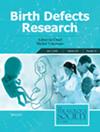Embryo-Fetal Developmental Toxicity and Toxicokinetics Studies of YWS1903, a Novel Potassium-Competitive Acid Blocker, in Pregnant Rats
Abstract
Background
In this study, we investigated the developmental and reproductive toxicity of YWS1903, a novel potassium-competitive acid blocker, in pregnant Sprague–Dawley rats.
Methods
YWS1903 was administered orally at doses of 0 (control), 20, 60, and 200 mg kg−1 from gestation days 6 to 17 (n = 24 per group). Concurrent toxicokinetic analysis was conducted to characterize the toxicokinetic profile and placental transfer of YWS1903.
Results
Aside from hair loss at the highest dose, no significant maternal toxicity was observed up to 200 mg kg−1. Fetal assessments revealed reductions in body weight and crown-rump length at 200 mg kg−1, alongside increased skeletal malformations, but no visceral abnormalities were detected. Toxicokinetic linearity studies revealed that within the 20–200 mg kg−1 dose range, both Cmax and AUC0-t of YWS1903 exhibited disproportionate increases following initial and final administrations. In the high-dose group, the escalation in AUC0-t substantially exceeded the corresponding dose changes, suggesting potential saturation of metabolic pathways at higher exposure levels. YWS1903 was shown to cross the placenta, although fetal plasma concentrations were consistently lower than maternal levels, suggesting reduced direct fetal exposure.
Conclusion
The no observed adverse effect level was established at 60 mg kg−1, supporting the compound's safety at moderate doses. These findings provide valuable insights into YWS1903's developmental and reproductive safety profile and offer reference for its clinical application as a therapeutic agent for gastroesophageal reflux disease.

 求助内容:
求助内容: 应助结果提醒方式:
应助结果提醒方式:


